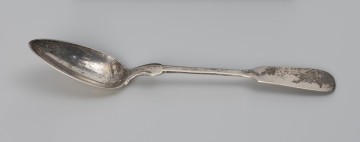
Creamer jug
1825 — 1835
National Museum in Lublin
Part of the collection: Craft and industry products of Szczecin
Tinsmithery was a craft that dealt with the production of vessels and other functional objects from tin and its alloys. The material was durable and aesthetically pleasing, and was used in the production of decorative items for churches, castles and the homes of the wealthy bourgeoisie. Over time, a number of unconventional tin everyday-use items were also built, such as water or milk jugs for storing water and warming pans for heating bed linen. In the Pomeranian region, one of the more thriving guilds of tinsmithers was located in Szczecin, with over 100 craftsmen professionally engaged in this trade between the 15th and mid-19th centuries. One of these was Andreas Oestmann, a native of Karlskrona, Sweden, who was granted the civil rights of Szczecin on 30 July 1756. As a citizen of the city, he made many different kinds of objects, among which was the featured pewter terrine of very striking form, imitating silverware. Corresponding objects may be found in the collections of the National Museum in Gdańsk (a slightly smaller edition), as well as the National Museum in Warsaw. Anna Lew-Machniak
Author / creator
Object type
tureen
Technique
casting, fine detail finishing, repoussage
Material
tin
Origin / acquisition method
purchase
Creation time / dating
Creation / finding place
Owner
Muzeum Narodowe w Szczecinie
Identification number
Location / status

1825 — 1835
National Museum in Lublin

około 1895 — 1910
National Museum in Szczecin

circa 1750 — 1770
National Museum in Szczecin
DISCOVER this TOPIC
Museum of King Jan III's Palace at Wilanów
DISCOVER this PATH
Educational path